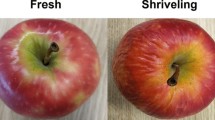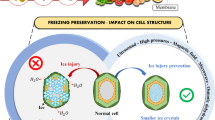Abstract
Cold tolerance studies were conducted under laboratory conditions for coccons ofAllorhogas pyralophagus Marsh, a Mexican parasitoid of graminaceous borers. By storage, developmental time (from cocoon to adult emergence) could be extended by 2 to 6 times. However, cocoons stored for more than 14 days at 2°C failed to survive, while at 5 and 10°C, about 50% emergence was recorded for upto 21 days of storage. With respect to survival and adult longevity, 10°C seemed to be the most suitable storage temperature. Pre-emergence period was also significantly increased by storing cocoons for 21 to 35 days at this temperature. Sex-ratio of emerging adults was not significantly affected by storage. Fecundity was adversely affected in all the treatments except in the case of females emerging from cocoons stored at 5°C for 7 days. The progeny of parasitoids which emerged from cocoons stored at 5 and 10°C for 35 days consisted of only males. It is clear from the present study thatA. pyralophagus cocoons are more amenable to short-term storage.
Résumé
Des études de tolérance au froid ont été réalisées sous conditions de laboratoire sur les cocons d'Allorhogas pyralophagus, parasitoïde mexicain des mineuses des graminées. Par conservation, le temps de développement (du cocon à l'apparition de l'adulte) pouvait être allongé de 2 à 6 fois. Cependant les cocons conservés durant plus de 14 jours à 2°C ne pouvaient pas survivre, tandis qu'à 5 et 10°C, 50% environ d'éclosion était enregistrée après 21 jours de conservation. Compte tenu de la survie et de la longévité de l'adulte, 10°C semblait être la température de conservation la plus favorable. La période de pré-émergence était aussi augmentée significativement en conservant les cocons, de 21 à 35 jours à cette température. Le sex-ratio des adultes éclos n'était pas affecté d'une façon significative par la conservation. La fécondité était affectée défavorablement dans tous les essais, excepté dans le cas de femelles émergeant de cocons conservés à 5°C durant 7 jours. La descendance des parasitoïdes issus de cocons conservés à 5 et 10°C durant 35 jours était uniquement mâle. Il ressort de l'étude présente que les cocons d'A. pyralophagus sont plus sensibles à la conservation à court terme.
Similar content being viewed by others
References
Anonymous. — 1986. Annual Report of All India Coordinated Research Project on Biological Control of Crop Pests and Weeds,Indian Inst. of Hortic. Res., Bangalore, p. 42.
Archer, T. L. &Eikenbary, R. D. — 1973. Storage ofAphelinus asychis a parasite of the green bug. —Environ. Entomol., 2, 489–490.
Archer, T. L., Murray, C. L., Eikenbary, R. D., Starks, K. J. &Morrison, R. D. —1973. Cold storage ofLysiphlebus testaceipes mummies. —Environ. Entomol., 2, 1104–1108.
Bennett, F. D., Cock, M. J. W. &Diaz, C. F. A. — 1983.Allorhogas sp. n [Braconidae] a potential biological control agent for graminaceous stem borers from Mexico. —Entomology Newsletter, Int. Soc. of Sugarcane Technologists, 14, 9–12.
DeBach, P. &Rao, S. V. — 1968. Transformation of inseminated females ofAphytis lingnanensis into factitious virgins by low temperature treatment. —Ann. Entomol. Soc. Am., 61, 332–337.
Eisler, J. I. &Pless, C. D. — 1972. Laboratory rearing ofLysiphlebus testaceipes onRhopalosiphon maidis. —J. Econ. Entomol., 65, 293–295.
Hanna, A. D. — 1935. Fertility and tolerance of low temperature inEuchalicida carybori Hanna [Hym.: Chalcididae]. —Bull. Entomol. Res., 26, 315–322.
Hawkins, B. A., Browning, H. W. &Smith, J. W. — 1987. Field evaluation ofAllorhogas pyralophagus [Hym.: Braconidae] imported into Texas for biological control of the stalk borerEoreuma loftini [Lep.: Pyralidae] in sugarcane. —Entomophaga, 32, 483–491.
Jayanth, K. P. &Nagarkatti, S. — 1985a. Mass rearing technique for a mexican parasite,Allorhogas sp. [Hym.: Braconidae] introduced for trials against graminaceous borers in India. —Entomon, 1, 43–46.
Jayanth, K. P. &Nagarkatti, S. — 1985b. Low temperature storage of adults ofBracon brevicornis Wesmael [Hym.: Braconidae]. —Entomon, 10, 39–41.
Melton, C. W. &Browning, H. W. — 1986. Life history and reproductive biology ofAllorhogas pyralophagus [Hym.: Braconidae], a parasite imported for release againstEoreuma loftini [Lep.: Pyralidae]. —Ann. Entomol. Soc. Am., 79, 402–406.
Rao, V. P. &Nagarkatti, S. — 1971. Can sugarcane borers in India be controlled by indigenous parasites? —Ind. Sug., 21, 219–223.
Smith Jr., J. W., Browning, H. W. &Bennett, F. D. — 1987.Allorhogas pyralophagus [Hym.: Braconidae], a gregarious external parasite imported into Texas, USA, for biological control of the stalk borerEoreuma loftini [Lep.: Pyralidae] on sugarcane. —Entomophaga, 32, 477–482.
Varma, A., Nigam, H. &Singh, K. — 1987. Laboratory and field evaluation of an exotic parasiteAllorhogas pyralophagus Marsh. [Hym.: Braconidae] against sugarcane stalk borer,Chilo auricilius Ddgn. [Lep.: Pyralidae]. —Entomon, 12, 367–372.
Author information
Authors and Affiliations
Additional information
Contribution No. 285/87 of the Indian Institute of Horticultural Research, Bangalore-560 089.
Rights and permissions
About this article
Cite this article
Ballal, C.R., Singh, S.P., Jalali, S.K. et al. Cold tolerance of coccons ofAllorhogas pyralophagus [Hym.: Braconidae] . Entomophaga 34, 463–468 (1989). https://doi.org/10.1007/BF02374383
Received:
Accepted:
Issue Date:
DOI: https://doi.org/10.1007/BF02374383




